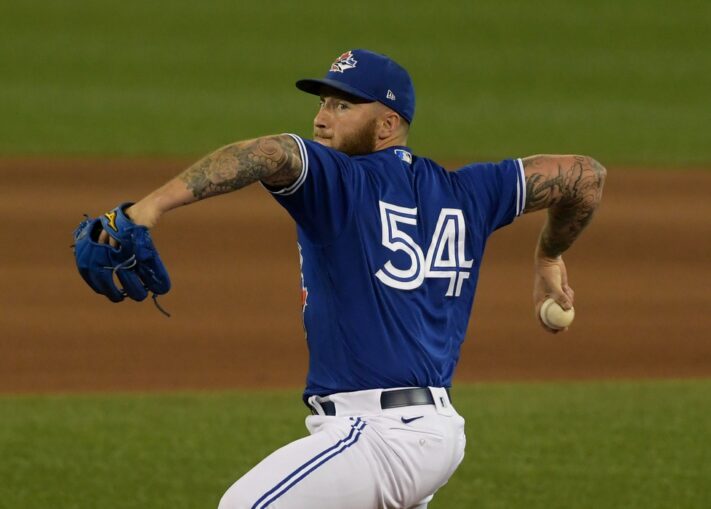
Credit: Dan Hamilton-USA TODAY Sports
In just a few weeks, pitchers and catchers will begin reporting to the New York Mets’ spring training facility in Port St. Lucie, meaning every single newcomer will undoubtedly be looking to make a solid first impression before the 2021 campaign opens.
While the offseason isn’t over just yet, the Mets have already conducted plenty of business this winter, especially when it comes to addressing their pitching staff. Along with acquiring pitchers Carlos Carrasco and Joey Lucchesi, the front office has also made several improvements to the bullpen, as they added relievers Trevor May and Aaron Loup.
In addition to these high profile acquisitions, team president Sandy Alderson and his staff have also done an incredible job at strengthening the club’s pitching depth on the 40-man roster. Showcasing this exact accomplishment earlier this week, management traded pitcher Steven Matz, who was a non-tender candidate earlier this offseason, to the Toronto Blue Jays in exchange for a trio of pitchers – including Sean Reid-Foley, Josh Winckowski and Yennsy Díaz.
Though this move was largely made to provide the Mets with additional tax space, which should allow them to acquire another impact player, it’s possible one of the pieces they received in return for Matz could make a surprising contribution at the major-league level next season. Despite owning just over 70.0 innings of experience in the majors, Reid-Foley seems to have finally found his footing at the highest level of competition and he could provide some upside as a weapon in the bullpen.
Starting his career in the rotation, the 25-year old was drafted out of high school as a starting pitcher and remained in that role as he further developed his craft within the Blue Jays’ organization. Considering he flourished at nearly every level of the minor leagues, most experts believed the right-hander would profile as a middle of the rotation arm, although he struggled mightily over his first 16 appearances in the major leagues.
From 2018-2019, Reid-Foley made 13 starts and compiled 65.0 total innings, producing a 4.71 ERA, 5.31 FIP, 5.21 xFIP, 1.63 WHIP, .253 AVG, .349 wOBA, 23.3% strikeout rate, 14.0% walk rate, 20.0% LD rate, 40.0% GB rate, 40.0% FB rate, 14.9% HR/FB rate and a 40.0% hard-hit rate.

Credit: Dan Hamilton-USA TODAY Sports
Digging deeper into his woes, the former second-round pick couldn’t perform effectively with his low-90s fastball, as it allowed a 45.5% hard-hit rate, a 34.5% LD rate and an 18.4% walk rate during that span. To make matters worse, he couldn’t generate any success with his mid-80s changeup, low-90s sinker or low-80s curveball, forcing him to rely solely on his mid-80s slider along with his four-seamer.
But since he was considered one of Toronto’s top young hurlers at the time, as he was ranked 10th on their top 30 prospect list in 2018, the front office continued providing him with starting opportunities through the end of the 2019 campaign. That being said, it probably would’ve been wise to provide him a shorter leash during that season, especially since it became clear his future playing career would likely be in the bullpen.
Even though Reid-Foley didn’t make the initial roster coming out of spring training 2.0 last season, he waited for his time to come and definitely made the most out of his opportunity when he was promoted to the majors late in the summer. Serving as a reliever this time around, the 6′ 3″ hurler looked like a completely different player and enjoyed plenty of success during his limited outings.
Despite allowing six walks over his 6 2/3 innings of work, the youngster still created a 1.35 ERA, 3.09 xERA, 4.09 FIP, .125 AVG, .212 wOBA, 5.6% LD rate, 61.1% GB rate, 33.3% FB rate, 33.3% hard-hit rate, and six strikeouts.
As for his repertoire, transitioning over to the bullpen has allowed Reid-Foley to reduce his pitch selection down to just three options (fastball, slider and changeup), which has definitely helped him take a positive step forward. Adding to this, lowering the righty’s workload to just an inning or two benefited both his heater and breaking ball throughout last season and that progress is something he’ll be aiming to continue moving forward with the Mets.
Starting with his fastball, the Sandalwood HS standout’s four-seamer ranged between 91-93 mph during his time as a starter, but he’s since increased its velocity to 94-96 mph as a reliever. As a result of this adjustment, the former Blue Jay has been able to locate his heater much higher in the strike zone, which has improved its average inches of drop by 2.9 inches.
Here’s an example of Reid-Foley’s fastball from last season:
Though Reid-Foley threw less than 100 fastballs in 2020, he still created plenty of swings and misses with his heater and barely allowed any contact against it. In total, his primary weapon posted a .083 AVG, .103 xAVG, .083 SLG, .124 xSLG, .227 wOBA, .246 xwOBA, 35.2% chase rate, 30.8% whiff rate (career-high), 25.0% strikeout rate and a 37.5% GB rate.
If he had qualified for the leaderboard, his four-seamer would’ve finished with the second-lowest xAVG and xSLG, the fourth-lowest SLG, and the fifth-lowest AVG among all pitchers who faced at least 25 batters, according to BaseballSavant.com.
While Reid-Foley will need to continue improving the location of his fastball, as it recorded a career-worst 25.0% walk rate last season, it should now be considered a plus pitch and its progression will likely help him enjoy a ton of success in his new role.
Along with his four-seamer, the former top prospect’s slider has also significantly improved following his transition to the bullpen, as its average velocity has increased from 83.8 mph in 2019 to 85.9 mph in 2020. Buying into the new age of the game, he also started improving his breaking ball’s spin rate, averaging 2,223 rpm last season compared to 2,166 rpm in 2019.
Thanks to these changes, the native of Guam’s secondary weapon allowed just a .167 AVG, .267 xAVG, .167 SLG, .301 xSLG, .145, wOBA, .246 xwOBA and it didn’t surrender a single walk. Additionally, it also produced an 80.0% GB rate, 33.3% chase rate along with a 26.3% whiff rate.
Here’s an example of Reid-Foley’s slider from last season:
Considering Reid-Foley’s slider only generated a 34% active spin percentage and averaged just 36.7 inches of drop last season, it’s certainly far from a finished product, but it’ll be crucial for the Mets’ coaching staff to help him unlock its full potential.
Taking into account his ability to perform effectively against both lefties and righties, as five of his six strikeouts from the 2020 campaign came against left-handed hitters, the former starter could serve as a multi-inning reliever in 2021. With the unpopular three-batter minimum rule expected to remain in place, it probably wouldn’t hurt to have another pitcher on the roster that can provide some length if needed.
Since New York’s bullpen currently features several arms who are capable of throwing multiple innings – including Robert Gsellman, Jacob Barnes, Corey Oswalt, Sam McWilliams, Thomas Szapucki, Stephen Tarpley and Daniel Zamora – Reid-Foley will probably be on the outside looking in once spring training rolls around. That being said, injuries are prone to occur over a full season and he’ll need to be ready to showcase his talents if he’s called upon to fill in as an injury replacement at some point.
With Reid-Foley under contract through the 2026 campaign, it’d be wise for the Mets to attempt to maximize his full potential, especially since he only has one minor-league option remaining. At some point next season, if he performs well during spring training and in the minors, of course, the front office will need to determine what they have in the young hurler and the only way to find out is to allow him to face some of the top hitters in the majors.
While it’s unlikely he’ll develop into a high-leverage reliever, although that could potentially change, one of the newest members of this team could still prove to be an extremely useful weapon in the bullpen during the 2021 campaign.














